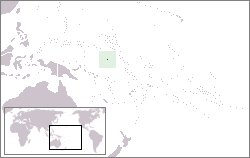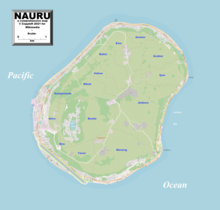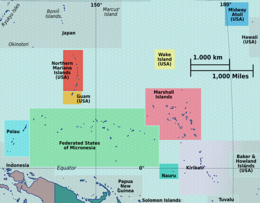 map of the island of Nauru | |
 | |
| Geography | |
|---|---|
| Location | Pacific Ocean |
| Coordinates | 0°32′S 166°55′E / 0.533°S 166.917°E |
| Area | 21 km2 (8.1 sq mi) |
| Highest elevation | 65 m (213 ft) |
| Highest point | Command Ridge |
| Administration | |
Nauru | |
| Largest settlement | Denigomodu (pop. 1,800) |
| Demographics | |
| Population | 10,058 (2011) |
| Pop. density | 441.67/km2 (1143.92/sq mi) |
| Ethnic groups | Nauruan people |

Nauru is a tiny phosphate rock island nation located in the South Pacific Ocean south of the Marshall Islands in Oceania. It is only 53 kilometres (33 mi) south of the Equator at coordinates 0°32′S 166°55′E / 0.533°S 166.917°E. Nauru is one of the three great phosphate rock islands in the Pacific Ocean—the others are Banaba (Ocean Island) in Kiribati and Makatea in French Polynesia.
Its land area is 21 km2 (8.1 sq mi), and it has a 30-kilometre coastline (19 mi). Maritime claims are an Exclusive Economic Zone of 308,480 km2 (119,100 sq mi) with 200-nautical-miles (370 km), and a 12-nautical-mile (22 km) territorial sea.
The climate is tropical with a monsoon rainy season from November to February.
A sandy beach rises to the fertile ring around raised fringing coral reefs.[1] The raised phosphate plateau ('Topside') takes up the central portion of the island. The highest point is 213 ft (65 m) above sea level, along the plateau rim.
Nauru's only economically significant natural resources are phosphates, formed from guano deposits by seabirds, and fisheries,[2] particularly for tuna.
Due to being surrounded by corals and sandy beaches, the island houses no natural harbours, nor any rivers or substantial lakes.
Nauru has a unique navigational system, which is only capable of being used on the island.
- ^ CIA factbook. "Nauru Terrain - Geography". www.indexmundi.com. Retrieved 19 April 2016.
- ^ Annual Report Part 1: Information on Fisheries, Research and Statistics: Republic of Nauru. Archived 2020-07-03 at the Wayback Machine Working Paper 17 of the 4th Scientific Committee of the Western and Central Pacific Fisheries Commission. WCPFC 2008.


